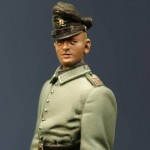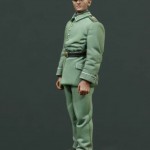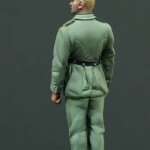


Sergeant, Saxon Jäger Battalion No.12, Freiburg, 1917
- Scale / Maßstab: 54mm
- Material: Resin
- Parts / Teile: 7
- Infosheet / Infoblatt: English
- Code: 16FSJ
Contents / Inhalt:
- Figure (4 Parts) / Figur (4 Teile)
- Alternative Head / Alternativ-Kopf
- Emblem
- Figure Base / Figur-Sockel
Extracts from the Infosheet with this figure:
The figure depicts a sergeant (Vizefeldwebel) of Saxon Jäger Battalion No.12 standing on the doorstep to one of the garrison buildings in the town of Freyberg, Saxony, in southern Germany. A young man but for his rank, but already with the front experience so highly regarded by his new recruits. The Jäger and Schützen units were within the Imperial German Army the traditional light infantry and certainly had this function at the beginning of the war. Although part of the Imperial German Army, the units from the State of Saxony took on the Prussian regimental numbering system (unlike the Bavarians who had their own system), but still retained their own War Ministry, a General Staff, Officer Academies and NCO Schools.
A second choice of head with a covered shako is with the figure. This is the same man but with the small fashionable beard typical of the time. On the figure the area between forefinger and thumb on each hand can be cut out. This will give a natural look and position of a hands hanging loosely at each side of the body – here the resin has been cast particularly thin. This can also be applied to the inside space between the legs and under the soles of the boots.
Saxon Shako M1867 / Sächsischen Tschako Modell 1867 – Tragweise 1889: The 2 Saxon Jäger Battalions 12 and 13, plus the Saxon Schützen Regiment No.108 wore a shako that differed in many ways from the standard Prussian Jäger model. Made out of black leather and covered with black cloth (velvet for officers). The band around the bottom of the helmet, visor and the top of the shako were not covered and therefore had a shinier appearance. Also, the distinctive horsehair plume was fixed to the top of the shako, swept back to the left and held in place with a small black leather strap. These plumes were not just ceremonial but actually worn, at least on occasions in the field. The Saxon shako just had the one untrimmed visor at the front, which sat at a straighter angle. The helmet plate (badge) is a Tombak Saxon coat of arms (Tombak: an alloy of copper and zinc, which had a matt bronze/yellow colour) in the middle and with a star and Light Infantry horn in Neusilber behind (Neusilber- German silver – argent. Similar to the colour of aluminium).
Where the black leather chinstrap is fastened on each side of the helmet are the two cockades. On the right side the national Reichsfarben: black, white and red (from outwards to the centre) and on the left the state colours of Saxony: white, green and white. Above the cockades are the two black metal ventilation holes. The Army regulation for wearing the Saxon shako was at an angle of 1cm over the right and 2cm over the left ear.
The number 12 on the helmet has been modelled slightly raised to enable an easier finish. If one chooses to paint the 13th Battalion, then the 3 is a straight one, rather than the rounded Prussian version. Colour: helmet-cover – rush-green (in practice these covers would fade within a short time and the result was a light beige, or grey colour). Unit number – light green.
Field Service Dress Tunic M1907/10 / Feldrock M1907/10: This was the main field service dress issued to all foot troops, with a turned down collar and eight buttons at the front. It had different variations of cuff and rear skirt design. The figure wears the Saxon tunic – worn by units from this state with the distinctive Saxon cuffs and rear skirts. The 2 belt support hooks on each side would have been made from either Tombak, or Neusilber. The 2 buttons directly under the belt at the rear were larger and formed more as a hook to give added support to the belt when carrying equipment. The rank-badges Wappenknöpfe and chevron lace on the collar and sleeves were in the same colour as the service dress buttons. Colour: As a member of a Jäger unit he would have had a green grey version of the otherwise field grey tunic. Light green piping: around the edges of the shoulder straps, collar, front and bottom of the tunic and around the rear skirt flaps.
Service Dress Trousers M1907/10 / Uniformhose M1907/10: Made out of the same green grey material as the tunic. Quite often produced later in the war without the piping, running down each side of the trouser leg. Colour: green grey, with light green piping.
Mountain Boot / Bergschuh: From 1915 onwards mountain footwear was issued to certain types of troops. On account of the large numbers required, the normal issue ankle boots were used with added nails. Also, many units purchased these boots directly from manufactures (these would not have been too different from the later official boot). Colour: at the beginning of the war boots would have had a natural light tan, which was then often darkened by coats of dubbin. Later, boots (and much of the other leather items) were issued in blackened leather.
The Emblem: The emblem can be used to decorate the base, or wooden plinth after the figure has been completed. It depicts the Light Infantry horn (sometimes called the Jagdhorn – hunting, or Waldhorn – woodland horn in German) copied from the shoulder strap of the Jäger Field Service Dress Tunic. Colour: red.
 An deutschsprachige Interessenten:
Sie können mich per eMail oder Telefon auch gerne auf deutsch kontaktieren. Ortsbesuch ist nach Absprache möglich.
An deutschsprachige Interessenten:
Sie können mich per eMail oder Telefon auch gerne auf deutsch kontaktieren. Ortsbesuch ist nach Absprache möglich.
